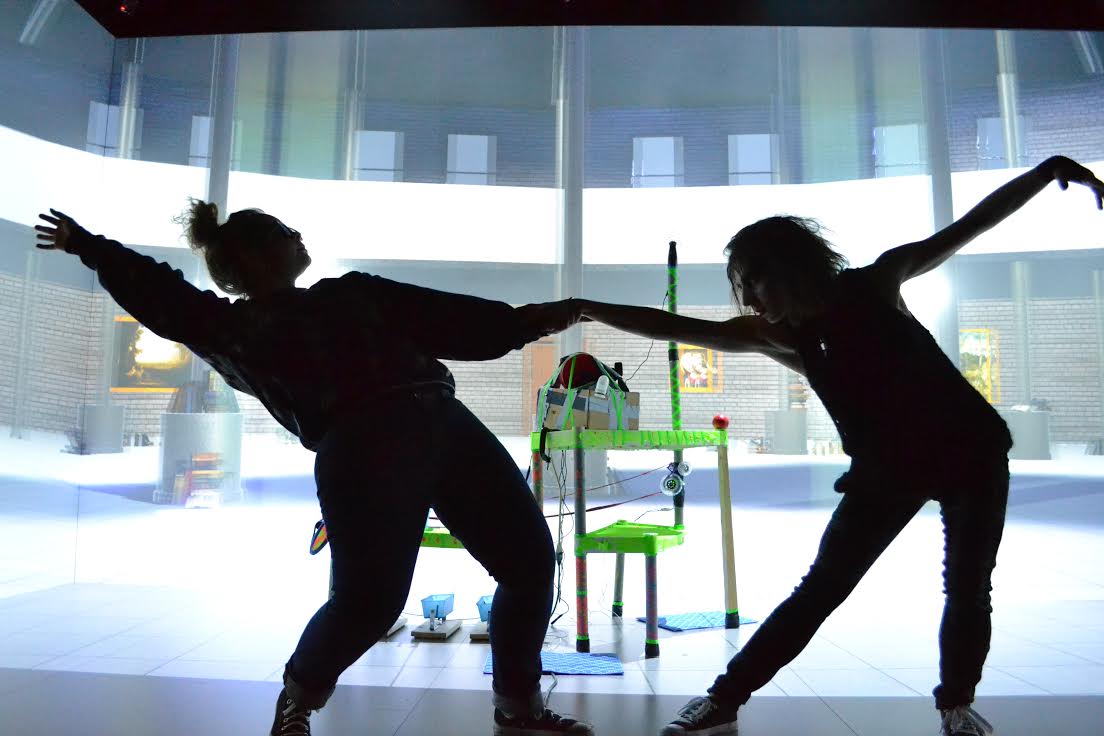
Sweet is the lore which nature brings;
Our meddling intellect
Misshapes the beauteous forms of things;
—We murder to dissect.
William Wordsworth
by Jeff Grygny
Rube Goldberg was an early 20th century cartoonist whose absurd contraptions were prime demonstrations of cause and effect: a bowling ball might roll down a chute to ring a bell, to wake a granny in rocking chair who triggers a mousetrap to release a clothes iron swinging on a rope, frightening a goat, and so on—all in pursuit of some mundane task. More recently, the band OK Go has created amazing videos inspired by Goldberg’s creations. Our childlike delight depends on that single kinetic moment, moving down the chain visibly like a sizzling fuse. It’s the basis of narrative, and you might even say, of science.
Fruition of a Delusion, the latest original performance currently in production by Cooperative Performance Milwaukee, not only features its own Rube Goldberg device, assembled onstage by the cast with theatrical flourish, but its very structure is Goldbergian: an assemblage of elements as diverse as they are incongruous. Not many shows bring together engineering with quotes from Ovid, Wordsworth, and William Blake, with burlesque, hip-thrusting dance moves, anti-nuclear sentiments, environmentalism, feminism, pop-culture snarkiness, quantum entanglement, call-outs to sci-fi classics like Back to The Future, Ghostbusters, and Doctor Who, and a musical palette that includes the Beatles, Queen, and that hipster classic, Europe’s “The Final Countdown.” If you’ve always craved to see the greatest scientists of the twentieth century re-visioned as a fusion of the Powerpuff Girls and SpongeBob SquarePants, this is your chance. It’s such an audacious concept, executed with devil-may-care casualness, it boggles the mind. But a Rube Goldberg machine depends on precision; unfortunately, this wild profusion of elements engage with each other in a messy, scattershot fashion, when they connect at all. Perhaps the best analog for the show’s collage aesthetic is right in front of your face: the internet, that collapses time, space and reason; where lofty thoughts walk side-by-side with adolescent pee jokes: it’s all just ones and zeroes, folks.
Maybe quantum entanglement is to blame. In a non-Newtonian system, there’s no reason to expect one thing to happen at a time: if particles in contact remain entangled when parted, and the universe was all once condensed in a single point, then everything is always connected to everything else; a single-function part is hopelessly simplistic— tyrannical even. Or it might have been co-creators Kelly Coffee and Don Russell’s intention to represent the inner landscape of its teenage protagonist as a blooming buzzing confusion, where science lessons and social media wisecracks coexist with equal weight. The show never references Star Trek: The Next Generation, though it echoes some of its middle-season plots: finding the solution to a technical problem while working out a parallel character problem. Here, it’s engineer Ruby’s quest to devise a sustainable source of energy for the world. In this task she enlists her imaginary scientist friends, who appear in the guise of cartoon characters. By the tone of the dialog, you can judge Ruby to be somewhere between eight and fifteen. It’s always a challenge for adult actors to play children; Molly Corkins keeps the winsomeness turned up to eleven. The forms of her interlocutors also suggest youthful fantasy: Sarah Ann Mellstrom presents the rumpled physicist Einstein in tight pants, a striped shirt, and leather jacket— possibly to suggest the connection between relativity and the Beatniks? In the role of Marie Curie, Anna Lee Murray sports a pink tutu, and is prone to postures such as lolling on the floor with her feet in the air (something it’s hard to picture her venerable namesake doing). As Atomic Spice (I mean the father of the atom bomb J. Robert Oppenheimer), Selena Milewski brings a punk/goth sensibility, all in black with heavy eye makeup, while Ben Yela gives visionary engineer Nikola Tesla a clownish fervor. The design process plays fast and loose as various concepts are floated; Eric Sherrer does a straight-man turn as the inventor of the fly swatter, whose duties include slapping ideas down. The real heroes of the show are the house band called “The Fallouts,” rocking an eclectic mix of live accompaniment with full-throated harmonies and great musical humor.

The Visualization Lab of Marquette University’s College of Engineering, which collaborated on this project, is in the impressively science-y basement of an impressively science-y glass and steel temple of technology. There, in a gray-walled alcove about the size of a large breakfast nook, projectors create 3D images which we view through polarized glasses. The effects are more nifty than awesome. Forget the holodeck—the graphics are reminiscent of late 90’s Second Life. With all of space and time to sample, the setting mostly consists of a rather drab library. The illusion of space is still impressive, though; bigger on the inside than on the outside.
Fruition of a Delusion highlights the truth that science, at least in its traditional form, works fundamentally differently than art: science takes things apart, looking at one entity or process at a time to understand the universe; art draws on infinite connections: historical and emotional, formal and metaphorical. Traditionally the artist carefully teases out threads of meaning to show patterns in the weave of life. Maybe, by refusing to cut its own Gordian knot, this show performs a different kind of heroism by letting us find our own way.
Cooperative Performance Milwaukee
in collaboration with MARVL
Marquette University’s Opus College of Engineering Visualization Lab
present
Fruition of a Delusion
Concept by Kelly Coffey
Written and directed by Kelly Coffee and Don Russell
Running through February 25
Marquette University Engineering Hall
1637 W. Wisconsin Ave Room Room 028 (lower level)
Tickets $20
“Due to limited seating, pre-ordering tickets is recommended. 3D glasses will be provided”
